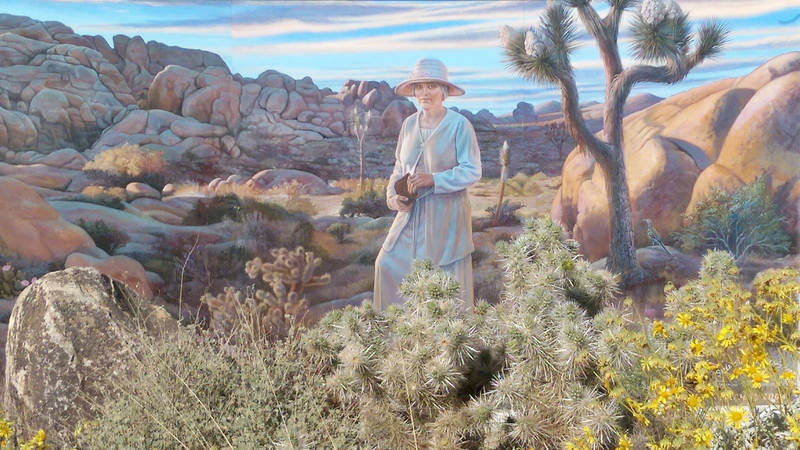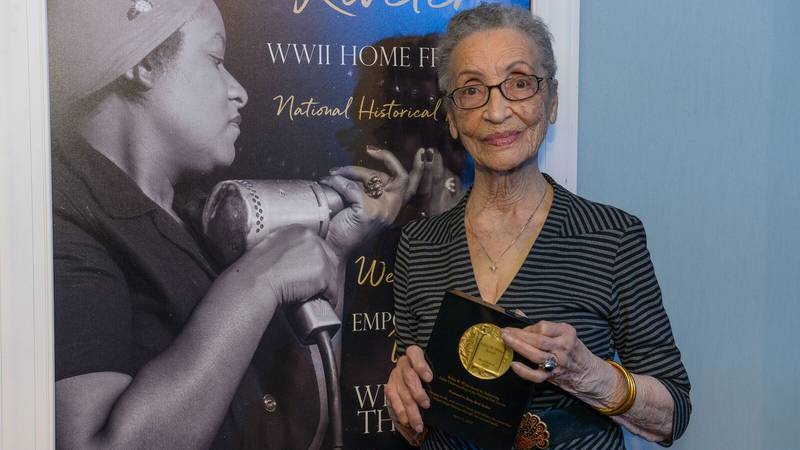Winter 2025
The Marvelous Ms. Marguerite
Yellowstone’s first full-time female ranger was a gun-toting, motorbike-riding bacteriologist born and raised in the park.
Marguerite “Peg” Lindsley turned more than a few heads the summer of 1924 when she rode her Harley-Davidson some 2,600 miles from Philadelphia to Yellowstone National Park with a friend in the sidecar. Lindsley, however, didn’t see what all the fuss was about.
“Lots of men make longer trips all the time and nobody thinks anything about it,” she told a reporter for Harley-Davidson’s The Enthusiast magazine. “Just because we’re girls, they think we’ve done something wonderful.”

These 10 National Parks Wouldn’t Exist Without Women
From Joshua Tree to Great Sand Dunes, these 10 special places are protected today thanks to their female champions.
See more ›Lindsley’s journey wasn’t a mere joyride. She was abandoning a burgeoning career as a lab scientist to get back to Yellowstone, where she was born, where her parents still lived, and where she would become the first permanent female park ranger. A century later, Lindsley’s story is one of several being celebrated in an exhibit called “Women in Yellowstone” at the Yellowstone Heritage and Research Center in Gardiner, Montana.
“The arc of her life was almost storybook,” said Alicia Murphy, Yellowstone’s first female historian. “I’m thankful there were people like her who blazed some trails that I could follow.”
Lindsley was born in Mammoth Hot Springs in 1901, when the park was still under military control and masked bandits occasionally robbed stagecoaches on its remote roads. Lindsley’s father was a civilian clerk for the U.S. Army who later served as the park’s acting superintendent, and her childhood was punctuated by the boom of a cannon at sunset and the sounds of bugling elk and yipping coyotes. At an early age, Lindsley learned how to handle a horse, ski, fish and fend for herself outdoors.
The arc of her life was almost storybook.
She was homeschooled by her mother until age 14 and later enrolled at a preparatory school in nearby Bozeman, spending summers in Mammoth, as Elizabeth A. Watry writes in her book “Women in Wonderland: Lives, Legends, and Legacies of Yellowstone National Park.” In 1921, at age 19, Lindsley was hired by Yellowstone’s new superintendent, Horace Albright, as a seasonal ranger to lead tourists on walks in the park. She was the third woman in that position, after Mary Rolfe, hired one day earlier, and Isabel Bassett Wasson, hired the year before. The following summer, Albright asked Lindsley to join a small team to research Yellowstone’s hundreds of place names and create a unified directory.
The staff of Yellowstone National Park, circa 1921. Lindsley can be seen in the second row.
NPSLindsley traveled across the country on her Harley-Davidson in 1924, returning home to Yellowstone where she would become the park’s first full-time female ranger.
BILL ARNOLD COLLECTIONLindsley in her ranger uniform with Rex, the horse.
BILL ARNOLD COLLECTIONAfter four years of premed coursework at Montana State College, Lindsley enrolled at the University of Pennsylvania in the fall of 1922. She got a master’s in bacteriology, and in 1923 she was offered a job in Philadelphia’s Mulford Laboratories. She lasted all of eight months before homesickness overcame her.
“I could almost smell the melting snow,” Lindsley later recalled in a letter, and “feel the thrill of an early morning (horseback) ride.”
IN GOOD COMPANY
With her meager savings, she bought the Harley and rode it west with her friend Claire Le Valle on a 17-day odyssey, navigating washed-out roads and inclement weather, until she pulled up, unannounced, at her parents’ doorstep in Mammoth, interrupting their dinner with visiting National Park Service officials, according to Watry’s book.
Though the motorcycle trek garnered a lot of attention, Lindsley said her greatest adventure was an expedition she undertook with three others the following winter: a 143-mile circumnavigation of Yellowstone on skis. The journey must have been grueling, but Lindsley was enamored. “Can you imagine,” she told a journalist, “geysers, rivers, waterfalls and lakes in the grip of winter with over 6 feet of snow on the level in places?”
In all seasons, Lindsley immersed herself in the park — at times literally. Once she was leading a group of tourists on a three-week horseback trip when, while on foot, she broke through the crust in the Artists’ Paintpots area and submerged her leg in boiling clay. Lindsley walked away with third-degree burns and a nickname: “Paint Pot Peg.”
In December 1925, Albright recognized Lindsley’s unparallelled knowledge of the park and hired her as a permanent ranger overseeing the Government Information Office in Mammoth. In that post, she talked to hundreds of tourists each day about wildlife, plants and geology. She maintained a wildflower exhibit and conducted lectures and walking tours. Yellowstone had never had a permanent female ranger before. (Mary Sullivan, who was hired in 1924 to oversee a remote Glacier National Park entrance, seems to have been the only other woman listed as a permanent female ranger before Lindsley, even though she only worked summers.) Between 1925 and 1959, only two other women would be hired for permanent positions in Yellowstone, according to Watry.

Trailblazers: Women Who Broke the ‘Green Ceiling’
Women have always been a part of our national parks, even when they weren’t widely recognized for their contributions. This two-part series for Women’s History Month highlights 14 women who…
See more ›For a uniform, Lindsley wore polished riding boots, jodhpurs, a flat-brimmed hat, a tailored blouse and tie, and a smart forest-green jacket complete with a pine-cone emblem on the sleeve indicating her full-time ranger status. She quickly made a splash. A Christian Science Monitor journalist described her as a “tall, clear-eyed, boyish-bobbed, slender young woman” who “fully deserves the commission which has been conferred on her.” In 1927, Lindsley met first lady Grace Coolidge who was visiting the park with her husband, startling a New York Times correspondent who was impressed by Lindsley’s uniform — and gun. That fall, Sunset magazine published a photo of her holding two large trout next to an article that said: “The summer college men who serve as temporary rangers all know that Peg excels them even in horsemanship as well as in scientific lore.”
Whenever possible, Lindsley escaped the crowds to spend time in nature alone. In the park journal Yellowstone Nature Notes, she documented one such evening when Yellowstone seemed to accept her as one of its own, a creature altogether at home there. Lindsley was standing alone on a bridge above a “velvet lined” riverbed, watching the moon rise over a meadow. Some primitive instinct made her throw back her head and howl into the stillness. When her echo faded, she howled again. From the far end of the meadow, a mother coyote and her two pups answered. Lindsley responded, and another group called out. “This time” she wrote, “the echoes chased each other around the hills for nearly two minutes before they all died away and quiet reigned.”
Many men seemed to have been smitten by Lindsley’s poise, intellect and competence in the outdoors. “She could marry anyone she wanted,” one male naturalist mused. She’d allow her suitors to sign the underside of her Stetson but for a long time she remained undistracted.

National Parks
You can read this and other stories about history, nature, culture, art, conservation, travel, science and more in National Parks magazine. Your tax-deductible membership donation of $25 or more entitles…
See more ›Eventually, however, she fell for a handsome ranger named Ben Arnold. They married in the spring of 1928. For them to be stationed together, Lindsley decided to give up her position as a permanent ranger and become a seasonal ranger naturalist instead. The couple lived at Tower Fall and later at the Northeast Entrance. In 1932, they had a son, William. The family cared for orphaned antelope fawns and bear cubs and fell into the rhythms of life within the park. “The deeper in its unspoiled wilderness we can be, the happier we are,” Lindsley wrote. “Busy summers flew by on swift wings and no winter was half long enough.”
Wolves had been extirpated from the park, but one winter, as Watry writes in her book, Lindsley and her husband found several feeding on an elk carcass. To see wolves return was almost a spiritual encounter for Lindsley, who described it as “one of the red-letter days of my life in Yellowstone.”
Lindsley died in 1952 of complications resulting from a car accident. A friend eulogized her with a poem that began: “A breath of Yellowstone left us today.” Her ashes were scattered in the park she loved, and a small brass plaque bearing her name was placed at the Mammoth Chapel.







